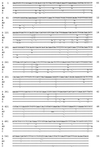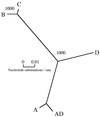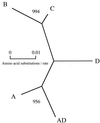Molecular analysis of CAP59 gene sequences from five serotypes of Cryptococcus neoformans
- PMID: 10698985
- PMCID: PMC86320
- DOI: 10.1128/JCM.38.3.992-995.2000
Molecular analysis of CAP59 gene sequences from five serotypes of Cryptococcus neoformans
Abstract
The nucleotide sequences of CAP59 genes from five serotypes of Cryptococcus neoformans were analyzed for their phylogenetic relationships. Approximately 600-bp genomic DNA fragments of the CAP59 gene were amplified from each isolate by PCR and sequenced. The CAP59 nucleotide sequences of C. neoformans showed more than 90% similarity among the five serotypes. By phylogenetic analysis, their sequences were divided into three clusters: serotypes A and AD, serotypes B and C, and serotype D. In addition, the results of reduced amino acid sequences were similar to the nucleotide sequence data. These data revealed that serotype AD was genetically close to serotype A rather than serotype D, although it had been considered to be a mixed type of serotype A and D by serological analysis. Furthermore, the nucleotide sequences of the serotype B and C isolates of C. neoformans were very similar to each other. These results indicated that serotype B and C isolates belonging to C. neoformans var. gattii were genetically homogeneous and closely related. The molecular analysis of the CAP59 gene will provide useful information for the differentiation of serotypes of C. neoformans and for an understanding of their phylogenetic relationships.
Figures




Similar articles
-
Molecular analysis of Cryptococcus neoformans mitochondrial cytochrome b gene sequences.J Clin Microbiol. 2003 Dec;41(12):5572-6. doi: 10.1128/JCM.41.12.5572-5576.2003. J Clin Microbiol. 2003. PMID: 14662942 Free PMC article.
-
Microreview: capsule-associated genes of Cryptococcus neoformans.Mycopathologia. 2007 Jan;163(1):1-8. doi: 10.1007/s11046-006-0083-0. Mycopathologia. 2007. PMID: 17216326 Review.
-
Molecular analyses of the serotype of Cryptococcus neoformans.Nihon Ishinkin Gakkai Zasshi. 2001;42(2):69-74. doi: 10.3314/jjmm.42.69. Nihon Ishinkin Gakkai Zasshi. 2001. PMID: 11331466 Review.
-
Capsule-associated genes of serotypes of Cryptococcus neoformans, especially serotype AD.Med Mycol. 2006 Mar;44(2):127-32. doi: 10.1080/13693780500286101. Med Mycol. 2006. PMID: 16519015
-
Differentiation of Cryptococcus neoformans varieties and Cryptococcus gattii using CAP59-based loop-mediated isothermal DNA amplification.Clin Microbiol Infect. 2010 Jun;16(6):711-4. doi: 10.1111/j.1469-0691.2009.02919.x. Epub 2009 Aug 20. Clin Microbiol Infect. 2010. PMID: 19694768
Cited by
-
Characterization of Cryptococcus neoformans var. neoformans serotype A and A/D in samples from Egypt.Folia Microbiol (Praha). 2003;48(2):261-8. doi: 10.1007/BF02930967. Folia Microbiol (Praha). 2003. PMID: 12800514
-
Comparative hybridization reveals extensive genome variation in the AIDS-associated pathogen Cryptococcus neoformans.Genome Biol. 2008;9(2):R41. doi: 10.1186/gb-2008-9-2-r41. Epub 2008 Feb 22. Genome Biol. 2008. PMID: 18294377 Free PMC article.
-
Molecular analysis of Cryptococcus neoformans mitochondrial cytochrome b gene sequences.J Clin Microbiol. 2003 Dec;41(12):5572-6. doi: 10.1128/JCM.41.12.5572-5576.2003. J Clin Microbiol. 2003. PMID: 14662942 Free PMC article.
-
Microreview: capsule-associated genes of Cryptococcus neoformans.Mycopathologia. 2007 Jan;163(1):1-8. doi: 10.1007/s11046-006-0083-0. Mycopathologia. 2007. PMID: 17216326 Review.
-
Difference in FKS1 gene sequences between serotypes A and D of Cryptococcus neoformans.J Clin Microbiol. 2003 Sep;41(9):4457-9. doi: 10.1128/JCM.41.9.4457-4459.2003. J Clin Microbiol. 2003. PMID: 12958293 Free PMC article.
References
-
- Ansheng L, Nishimura K, Taguchi H, Tanaka R, Shaoxi W, Miyaji M. The isolation of Cryptococcus neoformans from pigeon droppings and serotyping of naturally and clinically sourced isolates in China. Mycopathologia. 1993;124:1–5. - PubMed
-
- Bennett J E, Kwon-Chung K J, Howard D H. Epidemiologic differences among serotypes of Cryptococcus neoformans. Am J Epidemiol. 1977;105:582–586. - PubMed
-
- Felsenstein J. Confidence and phylogenies: an approach using the bootstrap. Evolution. 1985;39:783–791. - PubMed
-
- Fromtling R A, Shadomy H J, Jacobson E S. Decreased virulence in stable, acapsular mutants of Cryptococcus neoformans. Mycopathologia. 1982;79:23–29. - PubMed
MeSH terms
Substances
LinkOut - more resources
Full Text Sources
Other Literature Sources

